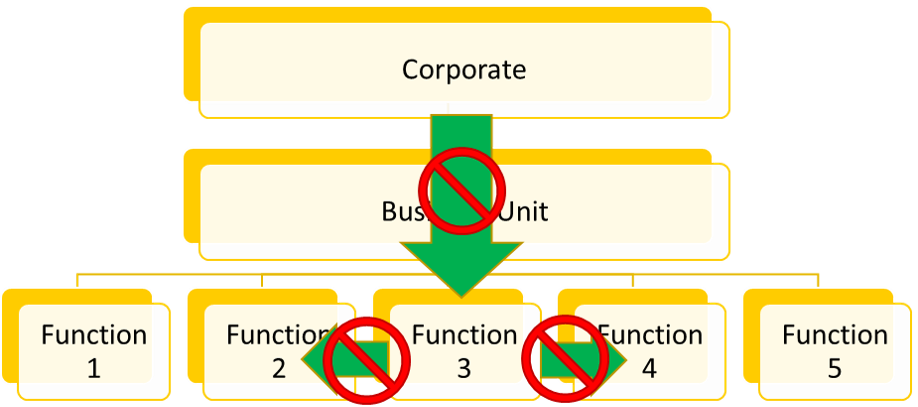
Like all functions, IP must be aligned to the goals of the business to be successful. However, what is often missing is the narrative that supports IP as part of strategic conversations within business – what could be called “IP Strategy”.
When any function is not tightly coupled to the rest of the business gaps appear, in activities, in policies, and in behaviours. These gaps become potential points for value to leak.
There is no IP Strategy – there is only Strategy
Organisational strategy is the selection, either deliberate or emergent, of a unique and valuable proposition rooted in the system of activities, which is difficult for competitors to imitate.
Strategic discussions address questions such as:
- How do we determine the shape, size and purpose of our organisation over time?
- How will the organisation achieve the necessary levels of economies of scope or scale, or technical innovation, to enable it to excel in the market place?
- How can we build and maintain complex resource clusters?
- Which of the organisation’s resources and capabilities are likely to need to change in response to external factors in the market, with technology, or due to politics?
- How do we monitor and revise our strategies so as to identify and respond to environmental turbulence?
- Which activities should our organisation continue to perform internally, and which should we rely on other organisations via outsourcing or alliances?
Organisational strategy is about defining goals, creating purpose and vision. What is often called IP strategy is commonly more about day-to-day operational requirements at the functional level.
Operational thinking is necessary, and IP specialist rightly focus on operational excellence, but operational excellence should be a given – it is necessary, but not sufficient.
Aligned thinking
Strategic thinking, by contrast, considers the performance of the corporate systems and activities in their entirety, and considered how all the activities connect and relate to each other in achieving the mission of the organisation. Strategic thinking asks not only how these activities work together, but also how they can be aligned, combined or performed differently to deliver a product or service of distinct value to the market.
For organisation strategy to be successful it must therefore consider all functions. When organisation strategy is aligned, each function is represented and considered in the resource and activity mix. Strategy is then produced as a set of trade-offs to produce the unique proposition. Further, as the organisation strategy is communicated from the corporate to the function, the function may further communicate implications to the other functions in terms of updated policies, processes or routines.

- When strategy is communicated from the organisation, through the business unit to the functional level its purpose is to set goals and create common purpose. While the strategy may not define the day-to-day behaviours of the function, it answers the question “why?”. For the IP function operational behaviours will include filing patents, registering and enforcing trademarks, and interacting with the rest of the business to capture potential innovations. These things must be supported with an understanding of why they are being done. Not only that, but given the longevity of some forms of IP the knowledge of current needs, must be supported with the understanding of future needs, and the gaps between now and then.
- Functions don’t interpret the corporate strategy in isolation. Once a function has determined the right operational approach, the approach or at least the implications of the approach, must be communicated to the rest of the business. For IP functions a failure to align approaches at the functional level is more likely to result in loss of value through unintended leakage of IP.
When organisation strategy is developed in the absence of any one function, or without considering the resources or available activities of that function, gaps appear which can lead to loss of value, and failure of the high-level strategy.
A failure to integrate IP into organisation strategy leads to two particular gaps:
- Between the high-level organisation strategy and the functional interpretation of those goals; and
- Between the IP function and the rest of the organisation.

Where organisations fail to integrate IP into a wider strategy these gaps, particularly the inter-functional implications, mean organisation value can be lost through unintended actions. Real examples that we have seen include:
- Marketing departments releasing product information detailing features ahead of formal protection, e.g. filing patents
- Customer Support / Helpdesk providing too much information about known problems to customers without suitable confidentiality arrangements – allowing customers to share information with competitors
- Product development lacking guidance on allowed forms of Open Source software contaminating deliverables with non-compatible license types
Such examples demonstrate that IP awareness across the business is essential.
What can be done to manage these risks?
Understanding your own IP and that of the main players in the landscape gives you valuable business intelligence to spot trends, to identify weaknesses and to build IP ahead of product roadmaps – maximising the value from your R&D.
- Do you have an IP strategy? When was it last reviewed, and by whom?
- Do you make financial provisions for new business cases for future licensing costs?
- Do you understand the IP landscape relating to your core and non-core technologies?
- Who are your real competitors and where do the IP threats come from? How do you plan to mitigate / manage these risks?
Download or get in touch
Cubicibuc Limited is an independent technical consulting firm specialising in matters relating to Intellectual Property.
We believe good IP management allows business to protect its competitive advantage; to generate returns on R&D investment and to secure investment and finance. Modern businesses neglect their IP assets at their risk as poor IP management gives away value and reduces barriers to entry for competitors compromising the organisation’s capabilities.
To manage IP well business must adopt a combination of commercial, legal and technical expertise – but always with a pragmatic focus to actively manage and exploit the IP.
